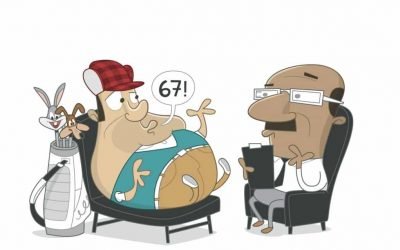
In golf, the only thing that matters is your score. In the very first paragraph of Ben Hogans book 5 Lessons, he makes this fact clear. As golfers, we are continually searching for anything that will improve our golf score. If a golfer says they are satisfied about shooting in the 90’s because they have fun, they are telling a white lie. Trust me, after every round, its always about the stupid 3 putt on 17 or the simple iron mistake on hole 3. Golfers desperately want to break 90, then 80, and 1 round in the 70’s and under-par rounds are the dream. You don’t have to lie to yourself or others. There is nothing fun about shooting high numbers in golf, golfing in red numbers is fun. How can you have more fun and lower your scores?
“Hate Bogey More Than You Like Birdie”
The best and most consistent golfers know to “hate bogey more than you love birdie.” Not all golf holes are easy, in particular, course architects design them to challenge your game, adding sand,water, and o.b, meaning birdies are hard to come by and violently exposing your weaknesses. For this reason, birdies are extremely exciting to make. The excitement level is so high, golfers try to birdie every hole. This creates an overly aggressive playing style and causes golfers to make decisions that bring bogey into play. In search for a birdie, they make a bogey.
Because of these decisions, golfers continue to shoot higher scores than they are capable of. Making a bogey has twice the impact on your score in comparison to a birdie throughout 18 holes. In route to shooting an under-par round, making birdie only succeeds for that 1 hole, leaving 17 more chances, whereas a bogey eliminates two holes. A bogey on hole 1 eliminates to opportunity for a successful under-par score, and also requires a birdie on a remaining hole just to get back on an under-par track. Anything over bogey should not be tolerated.
Your Plan to shooting 67:Play golf in red numbers shoot 67
Par 5s: Pick the easiest 2 of the 4 par 5’s to birdie. Relax and par the other 2, Hate Bogey on these 4 holes.
Par 3s: Regardless of pin positions, play all 4 for par, Hate Bogey on these 4 holes.
Par 4s: Some par 4’s are shorter than others and provide better birdie opportunities. Birdie 3 of 10 and Hate Bogey on all 10 holes.
A five under 67 with 5 birdies and No Bogeys on par 72 course.
Assuming you are comfortable with the course, you should map out a specific game plan. This includes what holes you are going to try for birdie on. If it helps you, write down a game plan on your scorecard, stay disciplined and stick too it. This will help you stay in the moment and not let recent results modify your plan of action on the upcoming holes. As you now know, making a bogey eliminates two holes, and if made on one of your planned birdie holes, can undoubtedly add further pressure as holes dwindle down. This can cause players to deviate from their game plan in hopes to squeeze out an extra birdie. Not staying in the moment.
A friend once explained he wanted peace of mind when hitting every golf shot. You achieve this by learning how to calculate risk-reward in every shot. Before you select a shot, get proficient at playing out specific scenarios in your mind. As long as you stay away from any decision or shot that will bring bogey into play, you will establish peace of mind in each shot as you calculate risk-reward. There are many golf holes that build in risk-reward trying to get players to make poor decisions. Again, learn how to play towards your strengths without exposing your weaknesses.
“Hate Bogey More Than You Like Birdie”
Good golf scores come from making the fewest mistakes, good misses, recovery shots, developing momentum, and putting performance. The reason golf is considered to be a grind is because the nature of the game is in constant par save mode. Top professionals hit between (12-14) GIR leaving most putts outside 15 feet. The other (6-4) holes require getting the ball up-and-down. Getting comfortable and developing momentum in the grind will allow you to carry on and play golf in red numbers. Read About What You Need To Practice To Shoot Lower Scores.
This inevitably puts pressure on your putter to protect the par, which I explain in considerable detail in the link above. Putting in reality starts from the tee box. Sticking to your game plan, weighing the risk-reward, and playing to your strengths will give you a better opportunity to place the golf ball on the green for a makeable putt. i.e uphill straight putts.
Some putts are easier than other, you already know this. The best putters usually have easier putts, it helps to know the fall line of the cup from the fairway. This of course is why PGA Tour Players carry around those yardage books that tell them everything under the sun. You could be the best putter in the world, but if you are above the hole it makes the game harder.
Remember, a bogey wastes a possible birdie hole and another, takes away remaining chances for birdie in your gameplan, introduces an agonizing necessity of forcing a birdie to get back on track, and which takes you out of your comfort zone introducing the possibility of making a second bogey by favoring the direction of risk in the risk-reward calculation phase, also known as the bogey train.
“Hate Bogey More Than You Like Birdie” to get off the train. Par is a great score.